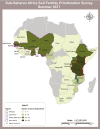Approaches to improve soil fertility in sub-Saharan Africa
- PMID: 31586430
- PMCID: PMC6946000
- DOI: 10.1093/jxb/erz446
Approaches to improve soil fertility in sub-Saharan Africa
Abstract
Soil fertility provides the foundation for nutritious food production and resilient and sustainable livelihoods. A comprehensive survey and summit meeting were conducted with the aims of understanding barriers to enhancing soil fertility in sub-Saharan Africa and providing evidence-based recommendations. The focus regions were West Africa, East Africa, the Great Lakes region, and Ethiopia. Overall recommendations were developed with four emerging themes: (1) strengthening inorganic fertilizer-based systems, (2) access to and use of quality organic inputs, (3) capacity building along the entire knowledge-transfer value chain, and (4) strengthening farming systems research and development across biophysical and socio-economic factors. The evidence-based process and methodology for prioritizing these recommendations makes these findings useful for setting out action plans for future investments and strategies. Access to inorganic fertilizer, its use, and related implementation issues were prominent considerations; nevertheless, biophysical and socio-economic barriers and solutions were identified as equally important to building soil fertility and natural resources. Soil management initiatives should focus on providing holistic solutions covering both biophysical and socio-economic aspects along the entire value chain of actors and creating an enabling environment for adoption. A broader view of soil fertility improvement using all available options including both inorganic and organic sources of nutrients and farming system approaches are highly recommended.
Keywords: Soil fertility; farming systems; resilience; soil degradation; soil health; sub-Saharan Africa; sustainable intensification.
© The Author(s) 2019. Published by Oxford University Press on behalf of the Society for Experimental Biology.
Figures
References
-
- Alliance for the Green Revolution in Africa (AGRA) 2016. Going beyond demos to transform African agriculture: the journey of AGRA’s soil health program. Nairobi, Kenya: AGRA.
-
- Annan K. 2004. Opening remarks—to end continent’s plague of hunger. Africa’s green revolution: a call to action. July 5, 2004, Addis Ababa, Ethiopia. UN Meetings Coverage and Press Releases, SG/SM/9405-AFR/988
-
- Bationo A, Kihara J, Kimetu J, Waswa B, eds. 2007. Advances in integrated soil fertility management in sub-Saharan Africa: challenges and opportunities. Dordrecht: Springer.
-
- Bayu W, Rethman NFG, Hammes PS. 2005. The role of animal manure in sustainable soil fertility management in sub-Saharan Africa: a review. Journal of Sustainable Agriculture 25, 113–136.
-
- Beegle K, Christiaensen L, Dabalen A, Gaddis I. 2016. Poverty in a rising Africa. Washington DC: The World Bank.
Publication types
MeSH terms
Substances
LinkOut - more resources
Full Text Sources


